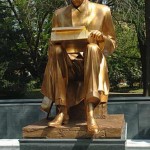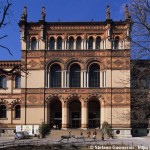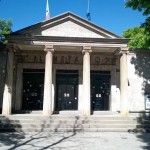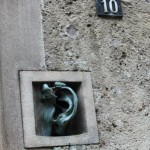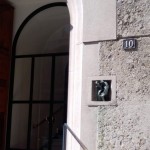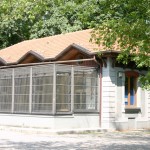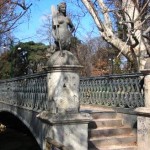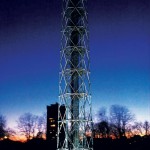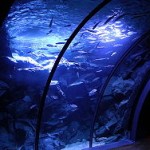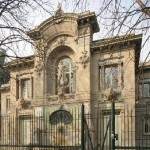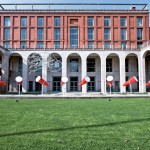the Parks in the heart of Milan
Milan city has got two important park:
The Public gardens and Sempione Park
THE PUBBLIC GARDENS AND ITS MUSEUMS
With an extension of about 17 acres, the Gardens are between corso Venezia, via Palestro, piazza Cavour, via Manin and the bastions of Porta Venezia. Since 2002, the Gardens are dedicated to the journalist Indro Montanelli (1909-2001), which is also dedicated a statue by the sculptor Vito Tongiani placed at the entrance of piazza Cavour.
Exit onto via Palestro, you stand in front of the Villa Reale , among the most significant examples of milanese neoclassical architecture, built between 1790 and 1796 as the sumptuous residence of count Lodovico Barbiano from Belgiojoso. For years it was the location where couples were merried in a civil ceremony in Milan.
Today the park of the Villa Reale host families with children who go to play in the area reserved for them with swings , slides and trails, and a lake with ducks.
You will find also the Civica Galleria d’Arte Moderna and the Padiglione d’Arte Contemporanea, exhibition venue, opened in 1954.
The public gardens, in addition to being a beautiful park where you can relax in Milan, which is always very busy , you can also grant moments of culture:
MUSEO CIVICO DI STORIA NATURALE one of the most important naturalistic museums in Italy .
National PLANETARIUM, one of the most prestigious educational institutions and disclosure related to astronomy and Astrophysics.
Curiosity:
Leaving the park on the side of the Planetarium, if you go in via Serbelloni 10 you can see an art nouveau house, with … EAR !!
This is the so-called “Ca dell’oreggia”(house of ear), so called because of the stone ear (actually an intercom now no longer functioning) next to the entrance door, realized by Andreani.
The legend quickly developed around this strange ear, sculpted in 1930, wants, whispering in his ear a wish, the wish will come true.
PALEOLAB
The Paleolab is the building, located within the Park, is the result of the restructuring of the cages of cats of former zoo in Milan. Now hosting an educational workshop, ideal completion of expositions of the Museum of natural history to explore the themes of human paleontology and mineralogy.
PALAZZO DUGNANI
Walking down viale Manin, in the gardens of Via Palestro (unerground stop Turati), a visitor cannot fail to notice the beauty of an aristocratic residence of the 17th century. This is Palazzo Dugnani, the 19th century became property of the city of Milan and from 1985 – for the next twenty years it housed the Cinema Museum Gianni Comencini, greenhouses and laboratories of some annual exhibitions. Today Palazzo Dugnani is chosen by couples who are choosing civil ceremony to the wedding day, so if you are lucky you can see the typical rice throwing ritual marriage Italian style. As for the Cinema Museum, the municipality – a year now – has embarked on a series of changes which include the transfer of the Museum at the former tobacco factory, in Milan, a large abandoned industrial pole (Bicocca area).
SEMPIONE PARK AND ITS MUMEUMS
The park covers an area of about 40 hectares. Made from 1890 to designs by Emilio Alemagna, hosted the pavilions of the international exhibition of 1906 (1906 EXPO) and is now the milanese Park par excellence, much frequented by athletes and families especially at weekends. It is not, however, only the green lung of the city, but a place that also tells the story of Milan. Inside, for example, is the bridge of Mermaids, named for the four statues that characterize it.
From the park there is a stunning panoramic view of the city by climbing the Torre Branca (Branca Tower 108,60 m high), built in 1932 by the Municipality of Milan. Designed by Gio Ponti and built in just two and a half months of work, was inaugurated on the occasion of the fifth Triennale (1933). Today at the base of the tower is located one of the most popular the “Just Cavalli”
Another attraction located in the park is the Acquario Civico ( Civic Aquarium), the only building left of those made in Milan on the occasion of International 1906. After restoration, completed in 2006, the interior space includes educational exhibition paths and research, with numerous pools of fresh and marine water containing more than a hundred species of aquatic organisms.
The park also host a public library a bit ‘special: its architecture has been awarded the Gold Medal at the Tenth Triennial in 1954.
Another symbolic place – that projects with its initiatives the city internationally and is located within the Parco Sempione – is The Foundation La Triennale di Milano , an institution for architecture, urban planning, design, decorative arts and visual, crafts, fashion, industrial and audiovisual production. It has its headquarters at the Palace of Art. The interior houses exhibitions rotating themes; on the ground floor leads to the Architecture Gallery, designed by Gae Aulenti in 1994 and dedicated to temporary exhibitions. In 2007, of the architectural design by Michele De Lucchi, the Triennale Design Museum was inaugurated, presenting every year a different set-up, changing the subject and curator.
SUMMARY
1)FASHION DISTRICT AND HISTORICAL CENTER
2)FROM THE MEDIEVAL HEART OF MILAN TO THE CASTLE
3)TICINESE DISTRICT AND NAVIGLI
4)FROM BRERA TO CORSO COMO
5)PORTA NUOVA DISTRICT AND ISOLA DISTRICT
6)CHINATOWN
7)OTHER DISTRICTS: sports district, Bicocca district
8)THE PARKS
